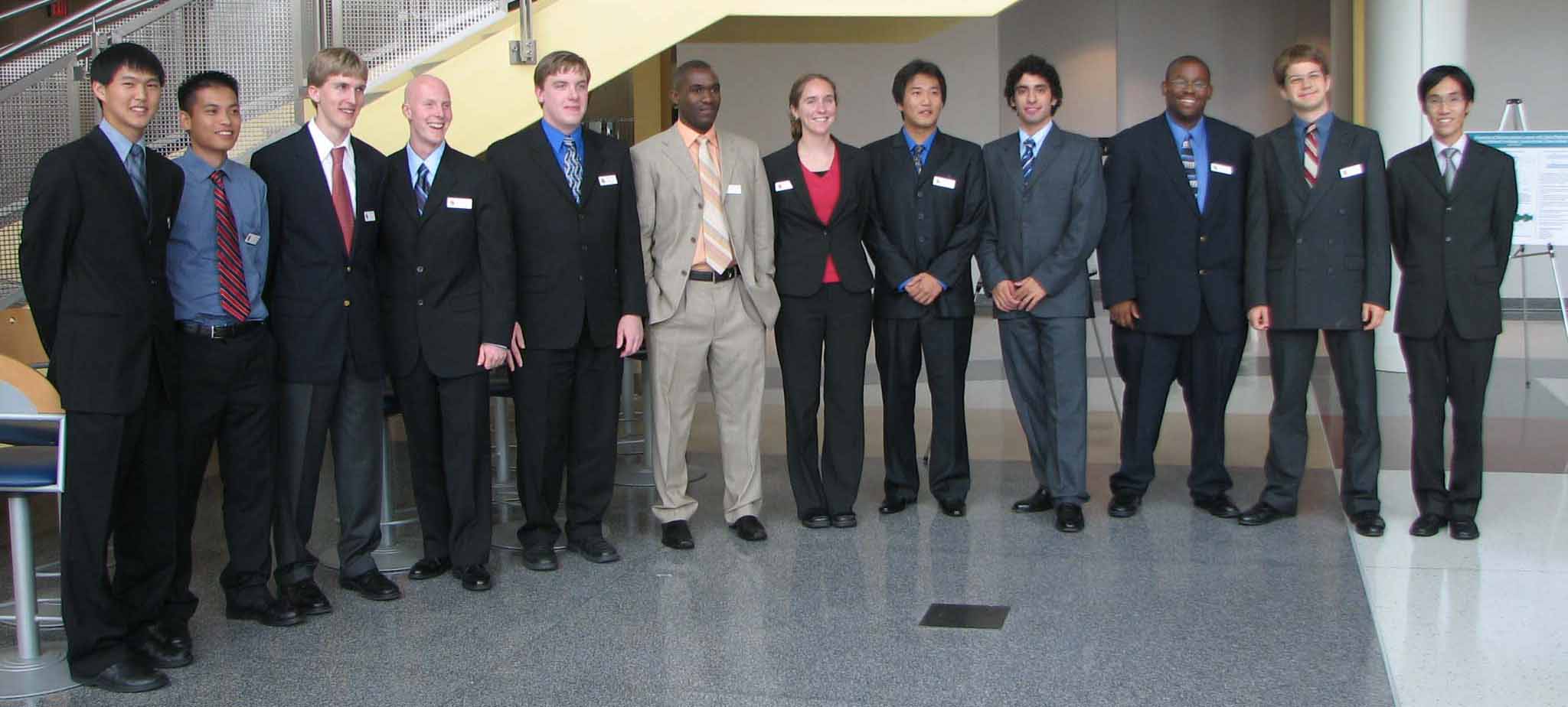| |
|
|
|
|
| |
|
|
|
|
| |
|
|
|
|
| |
|
MERIT
Fair 2007
|
|
|
| |
|
Overview, Project Abstracts, Presentation Slides & Posters, & Research Papers |
|
|
| |
|
Friday, August 10, 2007 |
|
|
| |
|
|
|
|
| |
|
|
|
|
| |
|
MERIT 2007 Student Participants
(click on photos to enlarge)
|
|
|
| |
|
The MERIT Fair is held
at the end of the summer to showcase the research conducted by the
undergraduate students during the summer. This forum provides them
with the opportunity to present their work to the wider public.
Their efforts are subjected to scrutiny form a panel of judges selected
from academia, industry, and government laboratories. Winners are
selected in each of the two areas of technical focus: MICRA
and RITE. The prize winning projects are listed just below with
a complete listing of all MERIT 2007 projects after that. |
|
|
| |
|
|
|
|
| |
|
MERIT
Fair 2007 Prize Winning Projects |
|
|
| |
|
|
|
|
| |
|
|
|
|
| |
|
Industry Sponsored Projects in Research and Engineering (InSPiRE) |
|
|
| |
|
|
|
|
| |
|
|
|
|
| |
|
Research Internships in Telecommunications Engineering (RITE) |
|
|
| |
|
|
|
|
| |
|
|
|
|
| |
|
INSPIRE Projects |
|
|
| |
|
|
|
|
|
|
Acoustic Echo Canceling: Echo Quality Index
Mengren Du (University of Maryland, College Park)
Mentors:
Dr. Bogdan Kosanovic (Texas Instruments Incorporated)
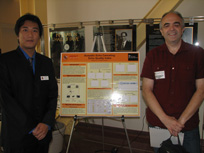 Evaluating the performance of Acoustic Echo Canceling (AEC) systems in telephony for full-duplex hands free operation is a challenging digital signal processing problem. This project used Fuzzy Logic to design an intelligent fuzzy inference system (FIS) that assigns quality index to AEC based on its debug statistics during phone conversations. Variations on conversation environment such as single or double talk, background noise, volume, and Non-Linear Processing were tested to examine their effects on AEC EQI. Matlab functions were developed to evaluate FIS with AEC debug statistics as inputs. However, further research is required to verify some parameters of the debug stats before FIS can function properly. Evaluating the performance of Acoustic Echo Canceling (AEC) systems in telephony for full-duplex hands free operation is a challenging digital signal processing problem. This project used Fuzzy Logic to design an intelligent fuzzy inference system (FIS) that assigns quality index to AEC based on its debug statistics during phone conversations. Variations on conversation environment such as single or double talk, background noise, volume, and Non-Linear Processing were tested to examine their effects on AEC EQI. Matlab functions were developed to evaluate FIS with AEC debug statistics as inputs. However, further research is required to verify some parameters of the debug stats before FIS can function properly.
Presentation Slides
Technical Report
|
|
|
| |
|
|
|
|
| |
|
RITE Projects |
|
|
| |
|
|
|
|
|
|
Determining Height and Gender of a Subject Using Gait
Michael Kuhlman (University of Maryland at College Park)
Mentors:
Prof. Rama Chellappa(UMCP),
Ashok Veeraraghavan(UMCP),
Aswin Sankaranarayanan(UMCP).
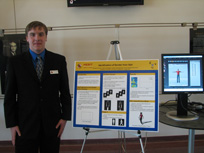 The aim of this study is to determine the height and gender of a subject from a video feed using computer vision algorithms. Psychological studies have shown that most sex-specific traits of gait are variations in lateral motion in the pelvic and shoulder regions. We compared the variance of movement from the traditional side view to the front view for determining gender. The front view captures the most lateral motion and therefore is the best view for determining gender. The aim of this study is to determine the height and gender of a subject from a video feed using computer vision algorithms. Psychological studies have shown that most sex-specific traits of gait are variations in lateral motion in the pelvic and shoulder regions. We compared the variance of movement from the traditional side view to the front view for determining gender. The front view captures the most lateral motion and therefore is the best view for determining gender.
We used Poser 7, a design and animation software package, to model walking subjects and to determine the accuracy of current height-estimation algorithms. We compared results from computer generated video to real world video using the same height-estimation algorithm.
Presentation Slides
Technical Report
|
|
|
|
|
Vehicle Identification Using Normalized-Cross Correlation
Peter Pham (University of Portland)
Mentors:
Prof. Christopher Davis(UMCP),
Prof. Stuart Milner(UMCP), and
Juan Carlos Franco (UMCP)
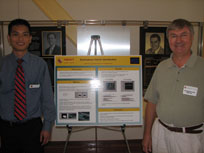 The goal of a real time autonomous surveillance system is to be able to identify interesting events (moving objects, abandoned objects, anomalous behavior, criminal acts, etc…) automatically and quickly without the need for a human operator. A complete autonomous surveillance system including cameras, wireless image transport, and “event detection” algorithms has already been developed by the Maryland Optics Group and the Center for the Networking of Infrastructure Sensors at the University of Maryland. This project has involved adding further functionality to the system by creating a program that can identify different car types in real time using Labview. Cropped screenshots of various car models were manually captured, then categorized and stored in a template database. This database is necessary to perform cross-correlation to identify vehicles found from a live camera. Experiments have shown a high success rate in identifying sedan, coupe and van. The goal of a real time autonomous surveillance system is to be able to identify interesting events (moving objects, abandoned objects, anomalous behavior, criminal acts, etc…) automatically and quickly without the need for a human operator. A complete autonomous surveillance system including cameras, wireless image transport, and “event detection” algorithms has already been developed by the Maryland Optics Group and the Center for the Networking of Infrastructure Sensors at the University of Maryland. This project has involved adding further functionality to the system by creating a program that can identify different car types in real time using Labview. Cropped screenshots of various car models were manually captured, then categorized and stored in a template database. This database is necessary to perform cross-correlation to identify vehicles found from a live camera. Experiments have shown a high success rate in identifying sedan, coupe and van.
Presentation Slides
Technical Report
|
|
|
|
|
Omni-directional Free Space Optical (FSO) High Speed High Bandwidth Laser Communication System
Kenneth Tukei (University of Maryland, College Park)
Mentors:
Prof. Christopher Davis (UMCP) and
Navik Agrawal (UMCP)
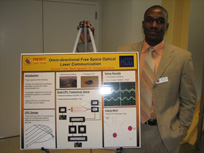 In a communication system, high bandwidth is often highly desirable. Laser based optical communication systems offer advantages in bandwidth and speed over traditional radio frequency (RF) communication systems. This project aims to build a miniature FSO high speed high bandwidth laser communication system that operates at around 10Mb/s. This system will operate either by direct line-of-sight, or possibly by diffuse reflection, from one or more laser transmitters to one or more photo-receivers. Each photo-receiver unit will utilize a compound parabolic concentrator (CPC), which has a large angular field of view and whose purpose is to collect and concentrate as much laser light as possible onto the photodiode. The CPCs will be made by a molding and electroplating process. Subsequently, the photo-receiver units will be integrated into a hemispherical structure with lasers and photodiodes to make a multi-beam transceiver.
More importantly, the outcome of this project will serve as a prelude to a combined laser-RF communication system. Because laser systems perform better where RF systems are limited and vice versa, the strengths of one can be used to overcome the weaknesses of the other. In a communication system, high bandwidth is often highly desirable. Laser based optical communication systems offer advantages in bandwidth and speed over traditional radio frequency (RF) communication systems. This project aims to build a miniature FSO high speed high bandwidth laser communication system that operates at around 10Mb/s. This system will operate either by direct line-of-sight, or possibly by diffuse reflection, from one or more laser transmitters to one or more photo-receivers. Each photo-receiver unit will utilize a compound parabolic concentrator (CPC), which has a large angular field of view and whose purpose is to collect and concentrate as much laser light as possible onto the photodiode. The CPCs will be made by a molding and electroplating process. Subsequently, the photo-receiver units will be integrated into a hemispherical structure with lasers and photodiodes to make a multi-beam transceiver.
More importantly, the outcome of this project will serve as a prelude to a combined laser-RF communication system. Because laser systems perform better where RF systems are limited and vice versa, the strengths of one can be used to overcome the weaknesses of the other.
Presentation Slides
Technical Report
|
|
|
|
|
Automatic Speaker Recognition
Ryan J. Amundsen (University of Miami)
Mentors:
Prof. Carol Espy-Wilson (UMCP),
Daniel Garcia-Romero (UMCP),
Vikramjit Mitra (UMCP),
Srikanth Vishnubhotla (UMCP), and
Xinhui Zhou (UMCP).
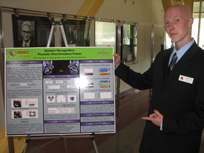 It is well known that American English speakers use a variety of vocal tract shapes to produce the /r/ sound. The two extreme postures are the "retroflex" /r/ and the "bunched" /r/. In this project, we will attempt to capture this variability in tongue posture by two methods. First, we will examine the difference between the fourth and fifth resonances of /r/. Second, we will determine whether any of the mel-frequency cepstral coefficients capture the variability. The objective is to find a direct relationship between the tongue posture and a distinguishing acoustic characteristic It is well known that American English speakers use a variety of vocal tract shapes to produce the /r/ sound. The two extreme postures are the "retroflex" /r/ and the "bunched" /r/. In this project, we will attempt to capture this variability in tongue posture by two methods. First, we will examine the difference between the fourth and fifth resonances of /r/. Second, we will determine whether any of the mel-frequency cepstral coefficients capture the variability. The objective is to find a direct relationship between the tongue posture and a distinguishing acoustic characteristic
Presentation Slides
Technical Report
|
|
|
|
|
Comparison of Acoustic Parameters and MFCCs for Speaker Identification
Alec Colvin (University of Maryland, College Park)
Mentors:
Prof. Carol Espy-Wilson (UMCP),
Srikanth Vishnubhotla (UMCP), and
Daniel Garcia-Romero (UMCP).
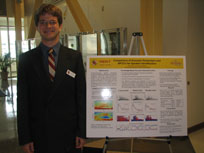 It has been demonstrated in the literature that the speaker identification performance using a feature set consisting of eight Acoustical Parameters (APs) is comparable to that of the standard set of features called the Mel-Frequency Cepstral Coefficients (MFCCs) in standard telephone databases. It is also known that the low-frequency spectrum is attenuated by telephone channels, which decreases the effectiveness of one of the APs -- the difference between the first two harmonics. The goal for this project is to repeat the experiment using high-fidelity broadcast recordings, where the harmonics are undistorted, and compare the performance of the APs and the MFCCs. It has been demonstrated in the literature that the speaker identification performance using a feature set consisting of eight Acoustical Parameters (APs) is comparable to that of the standard set of features called the Mel-Frequency Cepstral Coefficients (MFCCs) in standard telephone databases. It is also known that the low-frequency spectrum is attenuated by telephone channels, which decreases the effectiveness of one of the APs -- the difference between the first two harmonics. The goal for this project is to repeat the experiment using high-fidelity broadcast recordings, where the harmonics are undistorted, and compare the performance of the APs and the MFCCs.
Presentation Slides
Technical Report
|
|
|
|
|
A Study of Pursuit Algorithms on Pioneer Robots
Jansen Sheng (University of Maryland at College Park) and
Scott Watson (University of Maryland at College Park)
Mentors:
Prof. P. S. Krishnaprasad (UMCP),
Kevin Galloway (UMCP), and
Ermin Wei (UMCP)
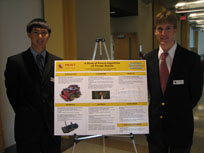 IThis summer's research goal is to investigate different types of pursuit games. We seek to develop feedback controls laws that will realize strategies such as classical pursuit, constant bearing pursuit, and motion camouflage, a strategy used in nature, for example, when hoverflies chase possible mates or when dragonflies engage in aerial territorial battles. (Echolocating bats hunt insect prey using a constant absolute target direction (CATD) strategy which is geometrically indistinguishable from motion camouflage.) These algorithms will be implemented on the Pioneer and ATV-mini robots using the high level motion control language MDLe. We aim to implement an extended Kalman filter for improved position estimation with Cricket sensors. IThis summer's research goal is to investigate different types of pursuit games. We seek to develop feedback controls laws that will realize strategies such as classical pursuit, constant bearing pursuit, and motion camouflage, a strategy used in nature, for example, when hoverflies chase possible mates or when dragonflies engage in aerial territorial battles. (Echolocating bats hunt insect prey using a constant absolute target direction (CATD) strategy which is geometrically indistinguishable from motion camouflage.) These algorithms will be implemented on the Pioneer and ATV-mini robots using the high level motion control language MDLe. We aim to implement an extended Kalman filter for improved position estimation with Cricket sensors.
Presentation Slides
Technical Report
|
|
|
|
|
Calculating the Electromagnetic Modes of Anisotropic Waveguides Using the Finite Difference Method
Arman Fallahkhair (University of Maryland at College Park) and
Kai Sum Li (New Jersey Institute of Technology)
Faculty Mentor: Prof. Thomas E. Murphy (UMCP)
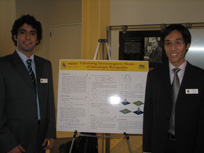 Numerical software is developed to calculate the electromagnetic modes of anisotropic waveguides using the finite difference method. Many materials used in integrated optical waveguides exhibit birefringence or anisotropy, yet most of the available numerical software is unable to accurately calculate the electromagnetic modes of anisotropic waveguides, especially in the general case when the principle axes of the material do not coincide with the waveguide axes. This project builds upon an earlier software package that handles the case of waveguides comprised of isotropic materials. Numerical software is developed to calculate the electromagnetic modes of anisotropic waveguides using the finite difference method. Many materials used in integrated optical waveguides exhibit birefringence or anisotropy, yet most of the available numerical software is unable to accurately calculate the electromagnetic modes of anisotropic waveguides, especially in the general case when the principle axes of the material do not coincide with the waveguide axes. This project builds upon an earlier software package that handles the case of waveguides comprised of isotropic materials.
Presentation Slides
Technical Report
|
|
|
|
|
Lightweight On-Chip Operand Decoding To Aid in Information Hiding
Malcolm Taylor (University of Maryland, Baltimore County)
Mentors:
Prof. Min Wu (UMCP),
Prof. Gang Qu (UMCP), and
Ashwin Swaminathan (UMCP)
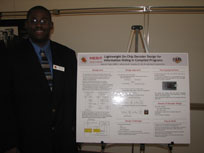 The importance of trusted computing has become more prevalent due to the increasing number of computer security threats. As this trend continues, there has been a push for modifying the underlying architectural base of a computer to directly aide in the creation of a secure computer environment. Using information hiding techniques at the instruction set level, it is possible to add data that can be used to implement a trusted computing environment. The goal of this project is to design a small footprint chip add-on to extract the hidden information so that it can be used for security purposes and also remap the instructions to their original form to allow for seamless architectural integration. The importance of trusted computing has become more prevalent due to the increasing number of computer security threats. As this trend continues, there has been a push for modifying the underlying architectural base of a computer to directly aide in the creation of a secure computer environment. Using information hiding techniques at the instruction set level, it is possible to add data that can be used to implement a trusted computing environment. The goal of this project is to design a small footprint chip add-on to extract the hidden information so that it can be used for security purposes and also remap the instructions to their original form to allow for seamless architectural integration.
Presentation Slides
Technical Report
|
|
|
|
|
Forensic Analysis of Cell Phone Cameras
Christine McKay (University of Maryland, College Park)
Mentors:
Prof. Min Wu (UMCP),
Ashwin Swaminathan (University of Maryland at College Park), and
Hongmei Gou (UMCP).
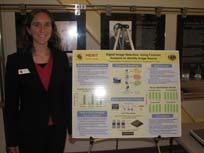 Non-intrusive component forensics involves identifying algorithms and parameters of a device based on its output data alone. This project extends several of these techniques from standalone digital cameras to cell phone cameras. Methods used include estimating a device’s color interpolation coefficients and noise feature parameters. Robustness to post-camera operations such as digital zoom and JPEG compression is also examined. This research applies to law enforcement and intelligence operations in differentiating between camera-, scanner-, and computer-generated images and determining the brand/model of the device used to capture an image. Further, this research is useful in identifying image tampering and patent infringement. Non-intrusive component forensics involves identifying algorithms and parameters of a device based on its output data alone. This project extends several of these techniques from standalone digital cameras to cell phone cameras. Methods used include estimating a device’s color interpolation coefficients and noise feature parameters. Robustness to post-camera operations such as digital zoom and JPEG compression is also examined. This research applies to law enforcement and intelligence operations in differentiating between camera-, scanner-, and computer-generated images and determining the brand/model of the device used to capture an image. Further, this research is useful in identifying image tampering and patent infringement.
Presentation Slides
Technical Report
|
|
|
| |
|
|
|
|

